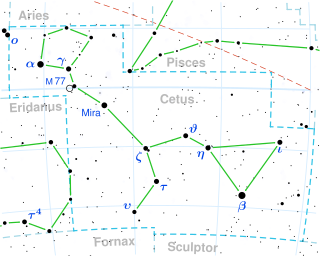
Mira, designation Omicron Ceti, is a red-giant star estimated to be 200–300 light-years from the Sun in the constellation Cetus.
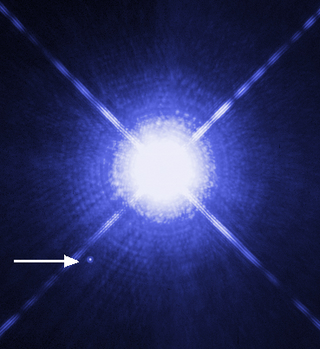
A white dwarf is a stellar core remnant composed mostly of electron-degenerate matter. A white dwarf is very dense: its mass is comparable to the Sun's, while its volume is comparable to the Earth's. A white dwarf's low luminosity comes from the emission of residual thermal energy; no fusion takes place in a white dwarf. The nearest known white dwarf is Sirius B, at 8.6 light years, the smaller component of the Sirius binary star. There are currently thought to be eight white dwarfs among the hundred star systems nearest the Sun. The unusual faintness of white dwarfs was first recognized in 1910. The name white dwarf was coined by Willem Luyten in 1922.
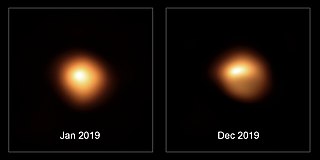
A variable star is a star whose brightness as seen from Earth changes with time. This variation may be caused by a change in emitted light or by something partly blocking the light, so variable stars are classified as either:

Asteroseismology is the study of oscillations in stars. Stars have many resonant modes and frequencies, and the path of sound waves passing through a star depends on the speed of sound, which in turn depends on local temperature and chemical composition. Because the resulting oscillation modes are sensitive to different parts of the star, they inform astronomers about the internal structure of the star, which is otherwise not directly possible from overall properties like brightness and surface temperature.

BPM 37093 is a variable white dwarf star of the DAV, or ZZ Ceti, type, with a hydrogen atmosphere and an unusually high mass of approximately 1.1 times the Sun's. It is 48 light-years from Earth in the constellation Centaurus and vibrates; these pulsations cause its luminosity to vary. Like other white dwarfs, BPM 37093 is thought to be composed primarily of carbon and oxygen, which are created by thermonuclear fusion of helium nuclei in the triple-alpha process.

RV Tauri variables are luminous variable stars that have distinctive light variations with alternating deep and shallow minima.

Giclas 29-38, also known as ZZ Piscium, is a variable white dwarf star of the DAV type, whose variability is due to large-amplitude, non-radial pulsations known as gravity waves. It was first reported to be variable by Shulov and Kopatskaya in 1974. DAV stars are like normal white dwarfs but have luminosity variations with amplitudes as high as 30%, arising from a superposition of vibrational modes with periods from 100 to 1,000 seconds. Large-amplitude DAVs generally differ from lower-amplitude DAVs by having lower temperatures, longer primary periodicities, and many peaks in their vibrational spectra with frequencies which are sums of other vibrational modes.

The unqualified term instability strip usually refers to a region of the Hertzsprung–Russell diagram largely occupied by several related classes of pulsating variable stars: Delta Scuti variables, SX Phoenicis variables, and rapidly oscillating Ap stars (roAps) near the main sequence; RR Lyrae variables where it intersects the horizontal branch; and the Cepheid variables where it crosses the supergiants.

HL Tau 76 is a variable white dwarf star of the DAV type. It was observed by G. Haro and W. J. Luyten in 1961, and was the first variable white dwarf discovered when, in 1968, Arlo U. Landolt found that it varied in brightness with a period of approximately 749.5 seconds, or 12.5 minutes. Like other DAV white dwarfs, its variability arises from non-radial gravity wave pulsations within itself., § 7. Later observation and analysis has found HL Tau 76 to pulsate in over 40 independent vibrational modes, with periods between 380 seconds and 1390 seconds.

G117-B15A is a small, well-observed variable white dwarf star of the DAV, or ZZ Ceti, type in the constellation of Leo Minor.

Ross 548 is a white dwarf in the equatorial constellation of Cetus. With a mean apparent visual magnitude of 14.2 it is much too faint to be visible to the naked eye. Based on parallax measurements, it is located at a distance of 107 light years from the Sun. It was found to be variable in 1970 and in 1972 it was given the variable star designation ZZ Ceti. This is a pulsating white dwarf of the DAV type that is the prototype of the ZZ Ceti variable class., pp. 891, 895.

PG 1159-035 is the prototypical PG 1159 star after which the class of PG 1159 stars was named. It was discovered in the Palomar-Green survey of ultraviolet-excess stellar objects and, like the other PG 1159 stars, is in transition between being the central star of a planetary nebula and being a white dwarf.
A PG 1159 star, often also called a pre-degenerate, is a star with a hydrogen-deficient atmosphere that is in transition between being the central star of a planetary nebula and being a hot white dwarf. These stars are hot, with surface temperatures between 75,000 K and 200,000 K, and are characterized by atmospheres with little hydrogen and absorption lines for helium, carbon and oxygen. Their surface gravity is typically between 104 and 106 meters per second squared. Some PG 1159 stars are still fusing helium., § 2.1.1, 2.1.2, Table 2. The PG 1159 stars are named after their prototype, PG 1159-035. This star, found in the Palomar-Green survey of ultraviolet-excess stellar objects, was the first PG 1159 star discovered.

GD 358 is a variable white dwarf star of the DBV type. Like other pulsating white dwarfs, its variability arises from non-radial gravity wave pulsations within the star itself. GD 358 was discovered during the 1958–1970 Lowell Observatory survey for high proper motion stars in the Northern Hemisphere. Although it did not have high proper motion, it was noticed that it was a very blue star, and hence might be a white dwarf. Greenstein confirmed this in 1969.
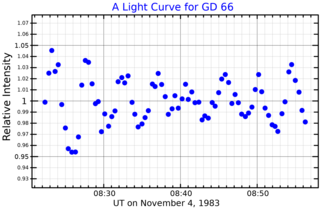
GD 66 or V361 Aurigae is a 0.64 solar mass (M☉) pulsating white dwarf star located 170 light years from Earth in the Auriga constellation. The estimated cooling age of the white dwarf is 500 million years. Models of the relationship between the initial mass of a star and its final mass as a white dwarf star suggest that when the star was on the main sequence it had a mass of approximately 2.5 M☉, which implies its lifetime was around 830 million years. The total age of the star is thus estimated to be in the range 1.2 to 1.7 billion years.

G 185-32, also known by the variable star designation PY Vulpeculae, is a white dwarf in the constellation Vulpecula. Located approximately 18.3 parsecs (60 ly) distant, the stellar remnant is a ZZ Ceti variable, varying by 0.02 apparent magnitudes from the mean of 13.00.
The kappa opacity mechanism is the driving mechanism behind the changes in luminosity of many types of pulsating variable stars. The term Eddington valve has been used for this mechanism, but this is increasingly obsolete.
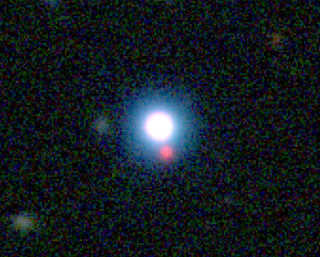
GD 165 is a system of a white dwarf and a brown dwarf of spectral types DA4 + L4, located in constellation Boötes at approximately 103 light-years from Earth. GD 165 B remained the only brown dwarf companion of a white dwarf until the discovery of GD 1400 B, which was discovered 17 years later.
MY Apodis, also known as L 19-2, GJ 2108, or WD 1425-811, is a single white dwarf star located in the far southern constellation Apus. It is a low-amplitude variable star with an average apparent visual magnitude of 13.75 and thus is much too faint to be visible to the naked eye. Based on parallax measurements, this star is located at a distance of 68.3 light-years from the Sun. It is drifting further away with a radial velocity of 58.0


















